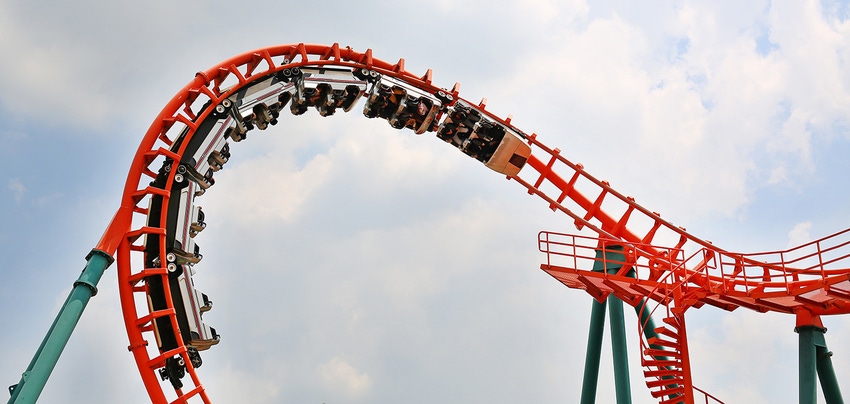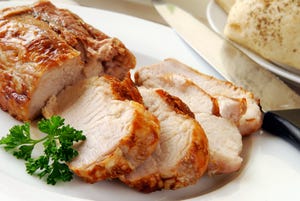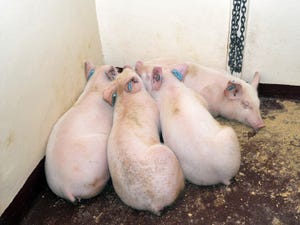Hog roller coaster ride continues
In addition to the disappointing fundamental back drop and weaker futures market than expected is the fact that U.S. hog producers continue to expand their herd.
August 26, 2019

This year has been a real roller coaster ride with the hog market. Prices traded lower in January and February despite the obvious spread of African swine fever in China.Then, suddenly prices shot higher during March and into April when the Chinese stepped into the U.S. market, making large purchases. The top in April was the high point of the roller coaster and prices turned lower and stayed lower right thought the summer months of June and July. Finally in early August it appeared that the roller coaster had bottomed and was set to screech higher for a while. And that brings us up to date. Is the ride still going higher or is the market headed lower into a new roller coaster low?
Generally speaking the market has been disappointing in terms of overall price performance especially in light of the hugely bullish long term fundamental at play in terms of ASF wiping out millions of pigs in Asia. Year-to-date U.S. pork production has been up 3.8% from last year. Exports have been, thus far, a major bust. Pork exports during the first six months this year were down 1.8% compared to last year. U.S. pork exports to Mexico, our largest pork trading partner, during the January through June period, were down 20%, first half exports to Japan were down 4.2%, down 11.7% to South Korea and down 12% to the Dominican Republic. First half exports to Chile were up 87%, up 46% to Australia and up 23.8% to Colombia.
While these are impressive trends it’s also important to notice these are still relatively small markets. Trade with Canada was up 9% and pork trade to China/Hong Kong was up 23.8% during the first half of this year. So in the first half China/Hong Kong represented a 10% export share compared to 25% for Mexico. Frankly, given solid evidence of severe problems in the Chinese hog herd, I expected Chinese exports to exceed that of Mexico by June of this year. It was not even close.
In addition to the disappointing fundamental back drop and weaker futures market than expected is the fact that U.S. hog producers continue to expand their herd. Why is the industry so intent on producing record large amounts of pork when the fundamental driver for such expansion, exports, has been so disappointing? If widespread and consistent profits are not readily available, why not reduce breeding stock? In Germany as soon as producers detected a drop in consumer demand for pork, they began liquidating breeding stock. U.S. producers don’t do that.
We are now approaching the fall hog runs and producers need to ignore the prospect of potential huge exports to China and hedge their production for the remainder of this year. The market place must prepare to clear record large amounts of red meat and poultry into an economic environment signaling for recession. Lower prices for hogs, cattle and poultry into the fourth quarter should be expected.
Longer term, I still believe the situation in China is so serious, so bullish that prices will recover next year, in spite of the fact that producers are still expanding. There is simply no point in trying to guess or out guess any resolution to the trade dispute between the U.S. and China. Even without a resolution China will have to come to the U.S. market, eventually, for increasingly large amounts of pork. For U.S. producers, remaining disease free is the key. The risk of this disease showing up in the U.S. was a major reason why one year ago I was expecting signs of contraction in the U.S. herd, not expansion. Thus far that expectation has been incorrect. I’m surprised that bankers are willing to finance in such an environment.
Evidence clearly shows that the spread of ASF continues through Asia, Eastern Europe and recently new cases have been reported in Russia. New cases have been reported in Russia’s Far East along the border with China. News out of Vietnam is quiet which likely means the spread is devastating their herd. The disease is threatening Bulgaria’s entire breeding herd of 600,000 sows. The table below shows the world pig population as of March of 2018 with notations in the right column.
China 440 million Losses estimated at 140 million to over 200 million
EU 150 million Germany contracting sows, prices rising substantially
U.S. 73 million Exports sluggish but industry still expanding
Brazil 39 million Herd stable but prices strong, up 70% in first half of 2019
Russia 23 million Trying to expand production but new ASF cases reported
Canada 14 million Prices strong off Asian demand but lost China trade
South Korea 11 million Stable production and deathly afraid ASF will show up
Mexico 10 million Trying to expand production
Japan 9 million Fighting classical swine fever
Some companies, companies with people in China, boots on the ground, believe that by the time ASF has run its course, the Chinese may lose up to 80% of their herd. The world has never experienced a protein gap of this magnitude. Exactly how this unfolds is impossible to gauge. If the U.S. remains disease free, hog prices in the months ahead stand a high chance of moving sharply higher.
The U.S. lean hog futures market is no longer willing to anticipate a higher price for hogs in the future due to the impact of ASF in Asia. On April 10, the National Pork Producers Council announced that the World Pork Expo, held in Des Moines every June was canceled. Their logic was sound, to protect the U.S. hog industry from being potentially exposed to the virus from visitors. It’s no coincidence, in my opinion, that futures topped out within a week of this announcement. Speculative money began to exit the market. Speculative money is still not willing to come into the lean hog futures market, not with the threat of ASF hanging over the market.
Looking ahead, however, the option market makers realize the potential of hog prices moving forward. For example, one year ago when the first case of ASF was detected in China, I turned instantly bullish and we started accumulating the June hog 120 calls for 45 points. At the time June futures were trading around $78. Today, one year later, the June hogs are trading at $85 and the June 168 calls are trading at 45 points. The lean hog option market makers are keenly aware of what can happen.
The next quarterly hog and pig report will be released on Friday Sept. 27. It would be rather exciting if this report showed an unexpected contraction. I doubt that happens. Looking ahead, I’m anticipating a major ... major seasonal low in lean hog futures prices at some point from the middle of October to the middle of November.
Source: Dennis Smith, who is solely responsible for the information provided, and wholly owns the information. Informa Business Media and all its subsidiaries are not responsible for any of the content contained in this information asset.
About the Author(s)
You May Also Like





